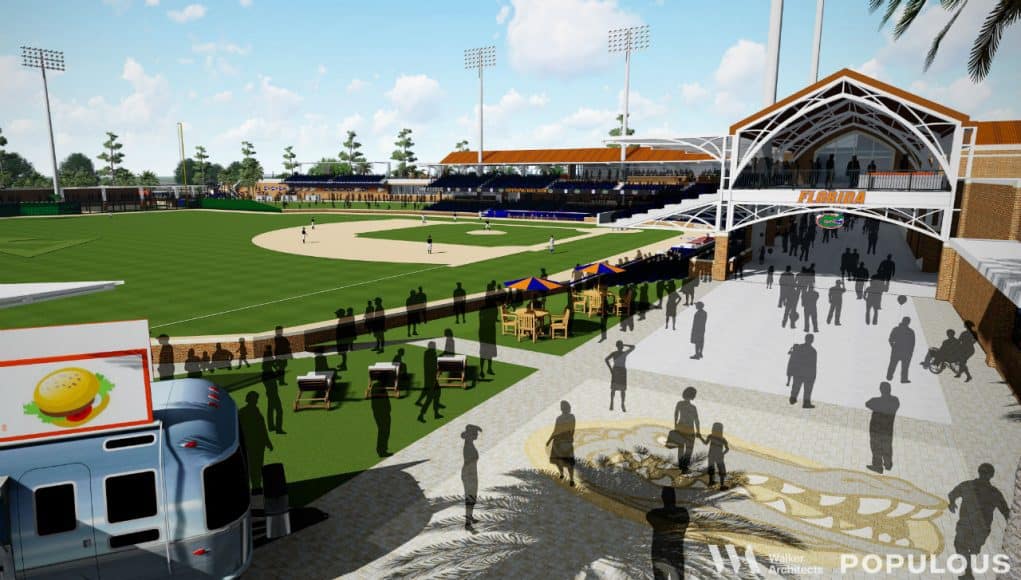My phone lights up on Wednesday afternoon. The number isn’t saved and the area code is unfamiliar. There is an invitation to see the Florida Gators’ new ballpark and the message is signed “Scott Stricklin”.
Twenty-four hours later I’m in a car with Florida’s athletic director on the way to see the brand-new $65-million baseball stadium. The park has quickly sprung from the Earth after a ground-breaking ceremony on February 8, 2019.
As we pull up to the construction site, Stricklin is beaming. He’ll go and see the progress at least once a week, if not more, but there’s so much happening every day that even he stops and takes pictures or asks questions while walking around. It’s been a long process.
When Stricklin was introduced as UF’s new athletics director, he brought with him a reputation of liking to build and advance athletic programs’ facilities. He had done just that at Mississippi State, and was even in the process of a $68-million dollar re-imagination of Duly Noble Field. In 2017, the Gators were still trying to figure out just what to do with a football facility that had limited space between practice fields, the football’s indoor facility, the Alfred A. McKethan baseball stadium, and the track facility. It was going to be a disjointed, three-story building that was really just going to be built to say they had a football-dedicated building. Just keeping up with the Joneses, really.
Then Chip Howard, Florida’s executive associate athletics director for internal affairs, posed an interesting question: what if they built a brand new baseball park on a piece of land near the softball stadium? Stricklin looked at the plans and concluded that – if they could raise the money – Florida would have the opportunity to build a truly special baseball park, while also giving the football team the necessary room to grow and build its own facility. The alternative would be to renovate McKethan Stadium, however, how long would that band-aid last on a 30-year old stadium? Would you pour $20 million into a renovation, only to have to come back and do even more in five years? 10 years?
The decision was made, the land was acquired and now, Stricklin is parking the car in the spot where the idea for a new stadium first began to take shape.
First, we need to find hard hats.
We walk around the outside of the park behind home plate where one of four entrances will be constructed, then around the first-base side. It’s a construction site like any other, littered with trailers and workers running around. Once we find the right trailer to acquire our hardhats, we can enter — doing so by walking directly through Florida’s bullpen and the right-field wall.
It doesn’t look like much right now. Workers are digging trenches to make way for an irrigation system, and gravel is being poured as a base for the sod and turf that will be laid down in early March.
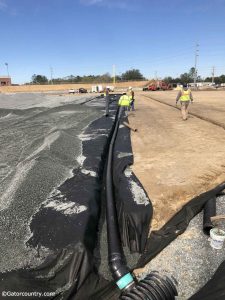
Stricklin is quick to point out that the wall in right field will be shorter than it is currently. He stands next to a post, telling me it will be about six feet. It’s around eight feet now, and he shows how tall it will be by putting his hand by his head, “I’m six feet tall, so around this height.”
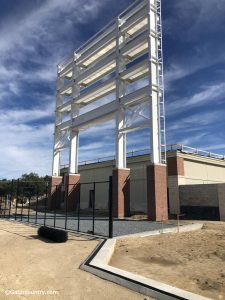
Just behind the bullpen is a massive structure that will hold a state-of-the-art video board. It’s actually the first thing you notice when driving down Hull Road, the new home street of the stadium. The board will be able to play video and replay of plays from the game, as well as advertise and show promotional videos throughout the game.
There is a grass berm area that stretches from the end of the 4,000-chairback seats — there will be no bleacher seating in the new stadium — all the way around the foul pole that sits 321-feet from the plate. I notice there is considerably less foul-ball territory here than at McKethan Stadium. The Mac isn’t a bad baseball park, but it does lack the intimacy that ballparks such as the great Wrigley Field have. The kind of park where you feel you’re right on top of the action. That would be the theme for the rest of the tour.
As we walked through every nook and cranny of the stadium, there isn’t a bad place in the whole park. There will be suites, and who doesn’t like a climate-controlled environment with food to watch a game? There is a party deck. There are the grass berms that extend from the chairbacks to around both foul poles, and there is — most importantly — shade.
The Gators haven’t had terrible attendance at McKethan Stadium, but far too many games in the middle of the week – and on Sunday – have been sparsely attended for a program of Florida’s caliber, to put it nicely. The Florida heat and humidity will conquer even a diehard baseball fans’ desire to watch a three-hour game, and it eliminated the casual fan from showing up in the past. Not at the new park. Outside of a few rows in the very front, everyone will be sitting in the shade. If you’re in the concourse, there will be fans above you and televisions showing the action, in case your view is obstructed – which you’d have a hard time finding in this place.
You can also take a stroll. The way the ballpark is being built, you can buy a drink from a concession stand behind home plate – even an alcoholic one if you so choose – and walk from there out around the berm, behind the left-field wall and into center field where there will be food trucks, tables, and an area just to hang out. Stricklin isn’t sure what that area will become, but it’s really up to the fans to make it what they want it to be. There will be more shade there, and the program is weighing having music or a screen to broadcast the game.
Keep walking and you’ll pass Florida’s bullpen, under that huge video board, and you can make it back around to center without ever missing any of the action on the diamond.
Our tour then goes down into the underbelly of the stadium. This isn’t an area that the public will see, but it’s where the student-athletes will essentially live. We step down into the Gators’ dugout, considerably more spacious than their current dugout. There’s a tunnel that leads from the dugout directly into a hallway. We take a left turn, and we’re in a massive space where four indoor batting cages will sit, with mounds for pitchers to get in bullpens when it’s raining. There is a new technology that doesn’t exist in the current setup.
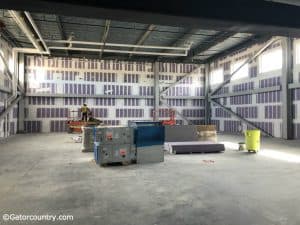
“It’s huge for us,” sophomore infielder Cory Acton said. “The new cages with video will be ten times better with video, a bunch of recordings and stuff like that to help us with our game.”
We head back down the walkway, and soon we arrive at the player’s lounge area, which will have the trainer’s office, a Gatorade nutrition bar, couches, and televisions — a place for the players to relax, eat, study or just hang out. Across the hall is their locker room, which will be much bigger and improved from the current setup. The biggest thing I notice is how it all seamlessly flows as if we’re in an HGTV episode with Chip and Joanna Gaines telling us how the open floor plan allows for a seamless transition from one room to another. It’s not just going to look nice – it’s going to be functional for the players.
We make our way through the tunnel that connects the two dugouts, where there is space for a whirlpool and training rooms. There are lockers for umpires and coaches, and we haven’t even mentioned the full-turf infield that will be built outside of the stadium on the right-field-side that doubles as an area for families and has even more entertainment during games.
Sitting in the party deck, just adjacent to a couple of suites in the second level of the stadium (check out the view of the field from here in the picture below), I turn to Stricklin and tell him he’s really thought of everything here.
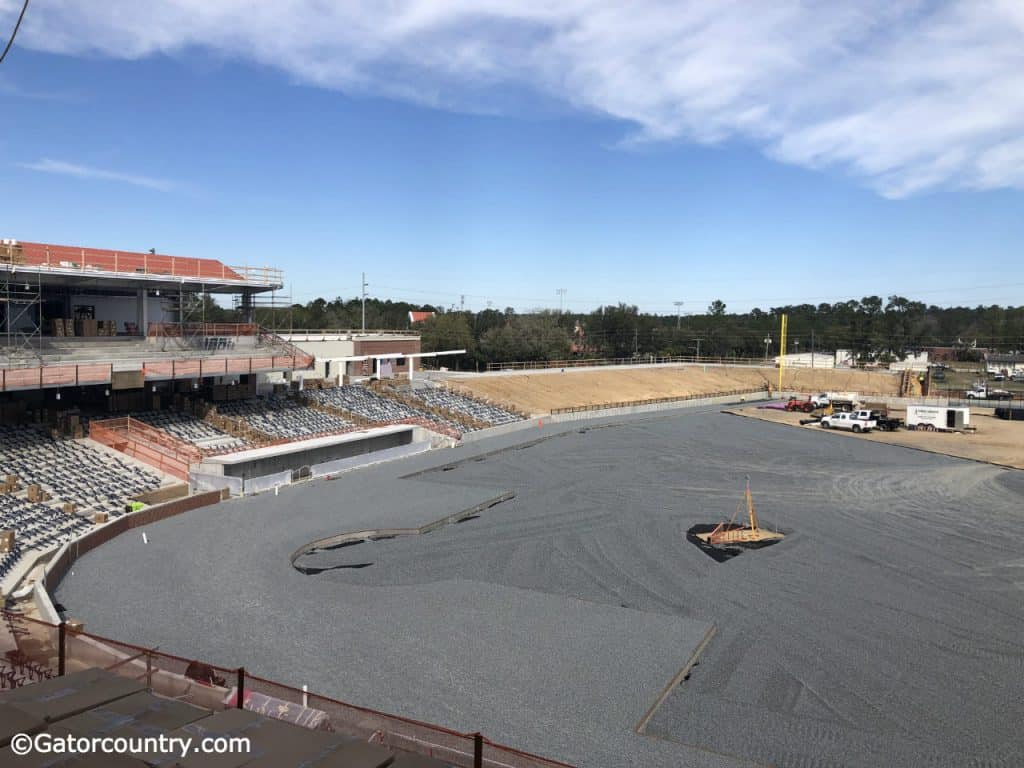
For me, a baseball guy who has covered more than 450 baseball games since 2013, it’s a beautiful park, with great sightlines and an intimate environment that you can’t help but romanticize watching baseball. For the casual fan, you can watch some of the game, walk around and go to a food truck, see what other entertainment the park and game day experience has to offer. There’s something for everyone.
In a week, the Gators baseball team will open up a new season in the same stadium they have played in for the previous 31 years. It will also be the last time the Gators open a season at McKethan Stadium, the new park will host games at the start of the 2021 season. The Mac has served them well for more than three decades, but the new stadium is something truly special.
Our tour finished, we make our way back out to right-center field, where Stricklin notes they plan to plant citrus trees in the area we’re standing — the University Athletic Association had to relocate dozens of citrus trees to make room for the stadium — as an ode to what was previously there. Standing there, looking from beyond the center-field fence, Stricklin has so many plans and hopes for the new park. He looks like Ray Kinsella did when he stood over and looked at his “field of dreams” in Iowa.
This is bigger, but the message and hope is the same.
“If you build it, they will come.”


